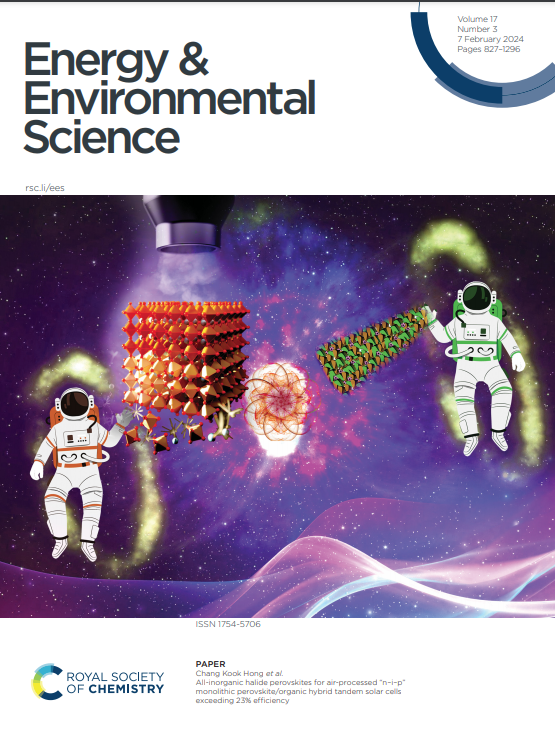Promoting Sulfur Redox Kinetics of Atomically Dispersed Fe-NC Electrocatalyst by Carbon Vacancy toward Robust Lithium-Sulfur Batteries
IF 30.8
1区 材料科学
Q1 CHEMISTRY, MULTIDISCIPLINARY
引用次数: 0
Abstract
Single-atom catalysts (SACs) have become the key to overcoming the inherent limitations of lithium-sulfur (Li-S) batteries for their exceptional catalytic activity, high selectivity, and strong affinity towards lithium polysulfides (LiPSs). The effectiveness of SACs is influenced by complex electronic structures. Accordingly, precise tuning of these surroundings is crucial to fully utilize SACs. In this work, we demonstrated that the performances of SACs in LiPSs redox reactions can be optimized by vacancy engineering. This strategy can retain the benefits of SACs as anchoring and electrocatalytic centers for LiPSs, while optimizing their electronic structures to promote rapid charge transfer and enhance LiPSs conversion efficiency. Specifically, iron-based SACs supported on nitrogen-doped carbon containing abundant carbon vacancies (Fe-SAs/N-Cv) were tested as a sulfur host in Li-S batteries. Density functional theory calculations indicate Fe-SAs/N-Cv effectively anchors LiPSs and reduces the decomposition energy barrier of Li2S. Thermodynamic analyses further elucidate that Fe-SAs/N-Cv can accelerate the LiPSs redox reactions. As a result, Fe-SAs/N-Cv hosts exhibit excellent rate performance and superior cycling stability. Furthermore, we demonstrated that with Fe-SAs/N-Cv can be applied in Li-S pouch cells to achievestable cyclability. This work showcases that the vacancy engineering strategy is effective to fine-tune the performance of SACs in Li-S batteries.碳空位促进原子分散Fe-NC电催化剂的硫氧化还原动力学
单原子催化剂(SACs)具有优异的催化活性、高选择性和对锂多硫化物(LiPSs)的亲和力,已成为克服锂硫(li -硫)电池固有局限性的关键。sac的效能受复杂电子结构的影响。因此,精确调整这些环境对于充分利用sac至关重要。在这项工作中,我们证明了SACs在LiPSs氧化还原反应中的性能可以通过空位工程来优化。该策略可以保留SACs作为锚定中心和电催化中心的优势,同时优化SACs的电子结构,促进快速电荷转移,提高lips的转化效率。具体来说,在含丰富碳空位(Fe-SAs/N-Cv)的氮掺杂碳上负载的铁基SACs作为硫宿主在Li-S电池中进行了测试。密度泛函理论计算表明,Fe-SAs/N-Cv能有效地锚定LiPSs,降低Li2S的分解能垒。热力学分析进一步表明Fe-SAs/N-Cv能加速LiPSs氧化还原反应。结果表明,Fe-SAs/N-Cv载体表现出优异的速率性能和循环稳定性。此外,我们证明了Fe-SAs/N-Cv可以应用于Li-S袋状电池中,以实现可循环性。这项工作表明,空位工程策略可以有效地微调Li-S电池中sac的性能。
本文章由计算机程序翻译,如有差异,请以英文原文为准。
求助全文
约1分钟内获得全文
求助全文
来源期刊

Energy & Environmental Science
化学-工程:化工
CiteScore
50.50
自引率
2.20%
发文量
349
审稿时长
2.2 months
期刊介绍:
Energy & Environmental Science, a peer-reviewed scientific journal, publishes original research and review articles covering interdisciplinary topics in the (bio)chemical and (bio)physical sciences, as well as chemical engineering disciplines. Published monthly by the Royal Society of Chemistry (RSC), a not-for-profit publisher, Energy & Environmental Science is recognized as a leading journal. It boasts an impressive impact factor of 8.500 as of 2009, ranking 8th among 140 journals in the category "Chemistry, Multidisciplinary," second among 71 journals in "Energy & Fuels," second among 128 journals in "Engineering, Chemical," and first among 181 scientific journals in "Environmental Sciences."
Energy & Environmental Science publishes various types of articles, including Research Papers (original scientific work), Review Articles, Perspectives, and Minireviews (feature review-type articles of broad interest), Communications (original scientific work of an urgent nature), Opinions (personal, often speculative viewpoints or hypotheses on current topics), and Analysis Articles (in-depth examination of energy-related issues).
 求助内容:
求助内容: 应助结果提醒方式:
应助结果提醒方式:


